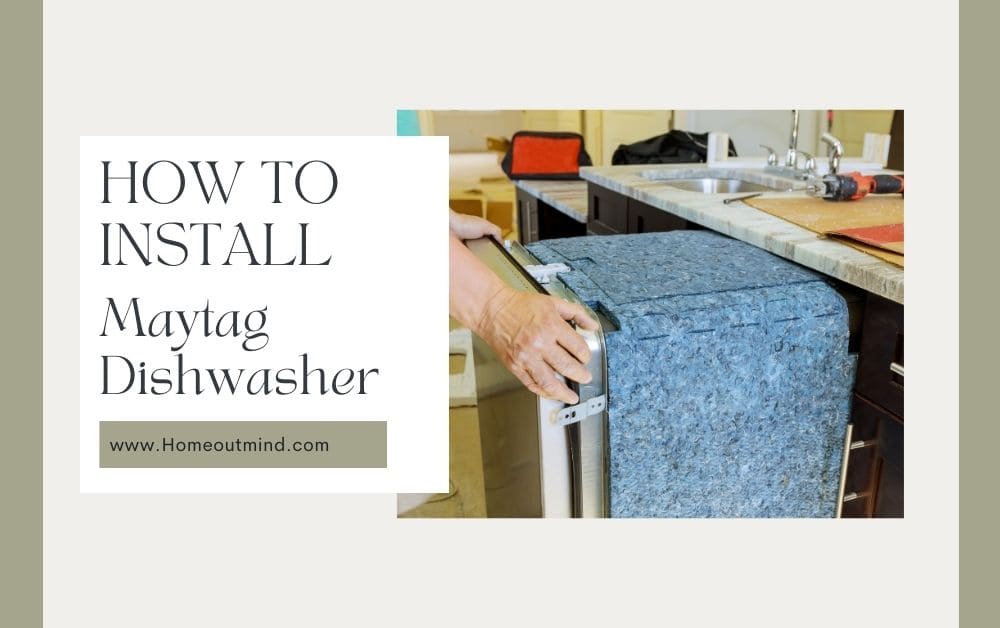Is this the first time you’re trying to install Maytag dishwasher? Are you find it difficult to install a dishwasher? And don’t you want to call a professional that will charge a lot of cash? And you don’t know where to start and which tools and parts you use?
This guide is for you we’ll explain how to install Maytag dishwasher step-by-step from a to z.
So please follow the steps and instructions and don’t skip any step because if you do that you’ll miss something and your dishwasher will not operate.
Discover a dishwasher that does more. With the most powerful motor on the market1 and sturdy stainless steel interiors, Maytag dishwashers will stand up to years of wiping grime and grit from your dishes.

What are the tools and parts you will need to install Maytag dishwasher?
Part needed:
- Philips screwdriver
- 5/16” and ¼” nut drivers or hex sockets
- 10” adjustable wrench that opens to 1 1/8” (2.9 cm)
- Flat-blade screwdriver
- Utility knife
- UL listed/CSA approved twist-on wire connectors
- Small level
- Pliers
- 5/8” open-end wrench
- Torx t20 screwdriver
Parts supplied:
- Drain hose clamps(2) (1 large and 1 small)
- Drain hose
- 10 x 1 2 Phillips head screws driver
- Undercounter mounting bracket (2)
Where should Maytag dishwasher be installed?
Check the location where the dishwasher will be installed. The location must provide:
- easy access to water, electricity, and drain.
- convenient access for loading and unloading dishes. Corner locations require a 2″ (5.1 cm) minimum clearance between the side of the dishwasher door and the wall or cabinet.
- square opening for proper operation and appearance.
- cabinet front perpendicular to the floor.
- level floor. (If the floor in front of the opening is not level with the floor at the rear of the opening, shims may be needed to level the dishwasher.)
Tip: Be sure to accurately measure dimensions and ensure the dishwasher is level if the floor in the dishwasher opening is uneven (example: Flooring extends only partway into the opening).
NOTE: To avoid shifting during dishwasher operation, shims must be securely attached to the floor
How to install Maytag dishwasher step-by-step
Step1. Disconnect power
- Disconnect electrical power at the fuse box or circuit breaker box before installing the dishwasher.
Step2. Shut off the water supply
- Shut off the water supply to the dishwasher.
Step3. Prepare Cabinet Opening — Existing Utilities
1. check water and electrical placement
If the waterline and the cable extend to the locations shown, proceed to the “Install Drain Hose” section. If they do not reach far enough, follow the instructions in the “Prepare Cabinet Opening— New Utilities” step below.
Step4. Prepare Cabinet Opening — New Utilities
Option A: Power Supply Cord:
NOTE: A grounded 3 prong outlet is required inside a cabinet next to the dishwasher cabinet opening.
1. power supply cord-drill hole
- Drill a 1¹⁄₂” (3.8 cm) hole in the cabinet side or rear.
2. power supply cord-prepare hole
Wood cabinet: Sand the hole until smooth.
Metal cabinet: Cover the hole with grommet included with power supply cord kit
Option B: Direct Wire:
Tip: Wiring the dishwasher will be easier if you route the cable into the cabinet opening from the right-hand side.
1. Direct wire- drill hole
Drill a 1¹⁄₂” (3.8 cm) hole in the right-hand cabinet side or rear.
2. Direct wire-prepare hole
Wood cabinet: Sand the hole until smooth.
Metal cabinet: Cover the hole with a grommet.
3. Direct wire-Route cable
Route cable from power supply through cabinet hole (cable must extend to the right front side of cabinet opening).
Tape cable to the floor. This will prohibit cable from moving when the dishwasher is moved into the cabinet opening.
Step5. Prepare and Route Water Line
Tip: Routing the waterline through the left side of the cabinet opening will make water connection easier.
1. Drill hole
Drill a ¹⁄₂” (1.3 cm) hole in the cabinet side or rear.
2. Measure water supply line (copper tubing only)
Measure the overall length of copper tubing for the water supply line.
3. Attach water supply line
Attach the water supply line (copper tubing or flexible braided line) to the hot water line using a connection configuration that complies with local codes and ordinances.
The water supply to the dishwasher should have a manual shutoff valve located under the sink.
4. Route water supply line
Slowly route the water supply line through the hole in the cabinet. (If you are using copper tubing, it will bend and kink easily, so be gentle.)
It should be far enough into the cabinet opening to connect it to the dishwasher inlet on the front left side of the dishwasher.
5. Flush water supply line
- Slowly turn the water shutoff valve to the “ON” position.
- Flush water into a shallow pan until clear to get rid of particles that could clog the inlet valve.
- Turn shutoff valve to “OFF” position.
6. Temporarily secure water line
Route water line and tape it to the floor. This will keep it from moving when the dishwasher is moved into a cabinet opening.
Step6. Install drain hose
1. Drill hole
If needed, drill a 1¹⁄₂” (3.8 cm) diameter hole in the cabinet wall or side of the opening closest to the sink.
2. Route drain hose.
Route drain hose as shown through a hole-in cabinet to the front center of the opening where drain connection will be made.
Tape drain hose to the floor. This will prohibit it from moving when the dishwasher is moved into a cabinet opening.
3. Connect drain hose.
Connect drain hose to waste tee or waste disposer using one of the following options:
Option A: waste disposer – no air gap
Option B: no waste disposer – no air gap
Option C: waste disposer –with air gap
Option D: no waste disposer –with air gap
The drain hose connection of the disposer or a waste tee must be made before the drain trap and at least 20″ (50.8 cm) above the floor where the dishwasher will be installed.
Helpful Tip: To reduce vibration of the hose, keep the hose away from the floor.
Option A: Waste disposer — no air gap
Helpful Tip: Remove disposer knockout plug.
1. Using a hammer and screwdriver, knock the plug into the disposer.
2. Use needle-nose pliers to remove the plug.
3. Attach drain hose to disposer inlet with large drain hose clamp (provided).
4. Use pliers to squeeze the clamp open and move it into position.
Option B: No waste disposer – no air gap
Option D: No waste disposer – with air gap
1. Connect the rubber end of the drain hose to the air gap and cut if needed.
NOTE: Do not cut ribbed sections.
2. Attach drain hose to air gap with large drain hose clamp (provided).
3. Use pliers to squeeze the clamp open and move it into position.
If the drain hose was cut, use a 1¹⁄₂” to 2″ (3.8 to 5 cm) screw-type clamp (not provided).
4. Use a rubber hose (not provided) with screw-type clamps (not provided) to connect from waste tee to air gap.
Step7. Prepare Dishwasher
1. Remove foam block
Remove and discard the foam blocks (if blocks are present) located above the front legs on each side of the dishwasher.
The blocks cover the rope/link pulleys on the dishwasher.
Helpful Tip: Place cardboard under dishwasher until installed in cabinet opening to avoid damaging floor covering.
Do not use the door panel as a worktable without first covering it with a towel to avoid scratching the door panel.
2. put dishwasher on its back
- Using two or more people, grasp sides of the dishwasher door frame and place dishwasher on its back.
3. Remove plastic rail cover
- Remove and discard the plastic rail cover on each side of the dishwasher frame.
To remove the plastic rail cover, push upward and back to unsnap it from the dishwasher frame.
4. Remove fasteners
- Using a flat-blade screwdriver, turn the plastic fasteners ¼ turn counterclockwise to unlock them. Remove panel.
- Do not remove the tech sheet from the access panel.
5. Remove panels
- Using a ¹⁄₄” hex-head socket, nut driver, or Phillips screwdriver, remove 2 screws attaching the access panel and lower panel to the dishwasher.
- Do not remove the tech sheet from the access panel.
6. Remove terminal box cover
- Using a ¹⁄₄” hex head socket, nut driver, or Torx® T20® screwdriver, remove the terminal box cover. Retain for later use.
7. Install strain relief
- Install a UL Listed/CSA Approved strain relief.
- Make sure screw heads are facing to the left when tightening the conduit nut. Strain relief is provided with the power supply cord kit.
Step8. Make Power Supply Cord Connection
1. Power cord-Route cord into the terminal box
Route cord so that it does not touch the dishwasher motor or lower part of the dishwasher tub. Pull the cord through strain relief in the terminal box.
Select UL Listed/CSA Approved twist-on wire connectors rated to connect your power supply cord to 16-gauge dishwasher wiring.
2. Power supply cord-Connect ground wire
- Remove the ground screw and place it through the ring terminal of the green ground wire.
- Reattach and tighten the ground screw.
3. Power cord-Connect remaining wires
NOTE: Do not pre-twist stranded wire. Twist on wire connector. Gently tug on wires to be sure both are secured.
Connect wires black to black and white to white, using UL Listed/CSA Approved twist-on wire connectors.
Wiring configuration:
| Power supply wire: | Terminal box wire: |
| White | White |
| Black | Black |
| Ground wire | Ground connector |
4. Power cord-secure cord on the strain relief
- Tighten strain relief screws to secure the cord.
5. Power cord-reinstall terminal box cover
- Place wires inside the terminal box.
- Insert tabs on the left side of the cover.
- Make sure wires are tucked inside the box.
- Close cover ensuring wires are not pinched. Use ¹⁄₄” hex-head socket, nut driver, or Torx® T20® screwdriver and previously removed screw to secure cover.
NOTE: Do not plug into an outlet until instructed to do so.
Step9. Determine cabinet opening
1. Measure cabinet opening
Measure the height of the cabinet opening from the underside of the countertop to the floor where the dishwasher will be installed (you will need to measure the lowest point on the underside of the countertop and the highest point on the floor).
Refer to “Dishwasher Height Adjustment Chart” for wheel position and the number of turns needed.
NOTE: If the minimum cabinet opening height is less than 34″ (86.4 cm), the rear wheels can be removed for additional clearance.
This will allow the dishwasher and perforated section of the insulation blanket to fit into a 33¹⁄₂” (85.1 cm) high cabinet opening, but the dishwasher will be more difficult to move.
Measurements are approximate. Wheels and legs are preset at the factory for 34¹⁄₂” (87.6 cm).
Dishwasher Height Adjustment chart:
| Cabinet opening height | Wheel position | Number of turns on the front leg |
| 33 ½” (85,1 cm) | Removed | All the way up |
| 34” (86,4 cm) | 1 | 10 |
| 34 ¼” (87,0 cm) | 2 | 5 |
| 34 ½” (87,6 cm) | 3 | 0 |
2. Adjust wheels and legs
- Turn both leveler legs to the same height.
- Put wheels in the required position determined from “Dishwasher Height Adjustment Chart.”
3. Built-up floors-Add shims as needed
Built-up floors: If the kitchen floor is higher than the cabinet opening’s floor.
for example, the kitchen floor tile does not extend into the cabinet opening – add shims as needed in the area shown to bring the dishwasher up to 34″ (86.4 cm) below the countertop.
NOTE: Shims must be securely attached to the floor to avoid movement when the dishwasher is in use.
Step10. Choose Attachment Option
1. Stand dishwasher upright
- Using 2 or more people, stand the dishwasher up.
IMPORTANT: The dishwasher must be secured to the cabinet. There are two brackets found in the parts bag.
Attach the brackets using Option A if the countertop is wood, laminate, or another similar surface. If your countertop is marble, granite, or another hard surface, install using Option B.
Option A: Countertop Attachment
1. Insert bracket
- Remove the brackets from the package and insert them into the open slots on the left and right-hand top of the dishwasher collar.
2. Bend tab
- Using a pair of pliers, bend the tab down to secure the bracket in place. Repeat this step for the other side.
NOTE: Do not attach the dishwasher. This will be done later.
Option B: Side Attachment
For marble, granite, or other hard surface countertops NOTE: Remove the brackets from the parts package.
1. Break end of the bracket
Break off the end of the bracket along the scored line.
With another person holding the rear of the dishwasher to keep it from tipping, open the dishwasher door and place towel over pump assembly and spray arm of the dishwasher.
This will keep screws from falling into the pump area when you are securing the dishwasher to the cabinet.
2. Remove plastic buttons
- Push the plastic buttons out of the side of the tub.
NOTE: Save the buttons to cover the holes after the dishwasher is installed.
3. Install bracket
- Push bracket into slot on the side of the dishwasher
- bend tab in toward the side of the dishwasher so that it keeps the bracket in place.
- Repeat this step for the other side of the dishwasher.
NOTE: Do not attach the dishwasher. This will be done later.
Step11. Move Dishwasher Close to Cabinet Opening
NOTE: Do not install kick plate until instructed to do so.
1. Move dishwasher close to the cabinet opening
Double-check the correct placement of utilities. Grasp the sides of the dishwasher at the edges of the door panel. Tilt dishwasher backward on wheels and move dishwasher close to cabinet opening.
NOTE: Do not push on the front of the panel or the console. Panel or console may dent.
Helpful Tip: Temporarily tape utilities to the floor in the locations shown to prohibit them from moving when the dishwasher is moved into the cabinet opening.
2. Check water and drain hose position
Check that the water line is on the left side of the opening and the drain hose is near the center of the cabinet opening.
3. Open and close the door
With another person holding the dishwasher to keep it from tipping, open and close the door a few times.
If the door closes or falls open under its weight, the door tension will need to be adjusted.
4. Closes too quickly-decrease spring tension
To adjust the door spring tension:
- unhook the spring from the rear leg of the dishwasher.
- Using a ⁵⁄₁₆” nut driver or hex socket, remove the screw from the tensioner.
The screw can be put into one of three holes (1, 2, 3) in the front leg of the dishwasher.
If the door closes by itself, move the tensioner to a higher number hole and replace the screw.
- Reattach door spring to the rear leg.
NOTE: Tensioners on both sides of the dishwasher should be secured at the same holes.
5. Door falls open – increase spring tension
When the door is unlatched and the door opens by itself, move the tensioner to a lower-numbered hole and replace the screw. Reattach door spring to the rear leg.
NOTE: Tensioners on both sides of the dishwasher should be secured at the same holes
6. Move dishwasher into the cabinet opening
If wheels were removed, cover the floor when moving the dishwasher to avoid damage to the floor. Slowly move the dishwasher completely into the cabinet opening.
Do not kink or pinch the waterline, drain hose, power supply cord, or direct wire between the dishwasher and cabinet. Remove the cardboard from under the dishwasher.
NOTES:
- It is all right if the dishwasher fits tightly into the cabinet opening. Do not remove the insulation blanket – the blanket reduces the sound level.
- If using a power cord, make sure to route the end through the hole in the cutout before sliding the dishwasher into the cabinet opening.
7. Align the front of the dishwasher with the front of cabinet doors
Align the front of the dishwasher door panel with the front of cabinet doors. You may need to adjust the alignment to be even with your cabinets.
8. Check for plumb and adjust legs if needed
Check that leveling legs are firmly against the floor. Close and latch the door, and place level against the front panel.
Check that dishwasher is centered from front to back in the opening. If needed, adjust leveling leg until the dishwasher is plumb. Repeat for another side of the dishwasher.
Helpful Tip: Push up on the front of the dishwasher to raise the dishwasher off the ground to adjust the front legs. With some installations, it may be easier to adjust the front leg using the ³⁄₁₆” hex head socket or adjustable wrench.
9. Check level side-to-side and adjust legs if needed
- Place level against top front opening of tub.
- Check that dishwasher is level from side to side.
If the dishwasher is not level, adjust front legs up or down until the dishwasher is level. Close the dishwasher door.
Step12. Connect to Water Supply
1. Slide nut and ferrule onto tubing (copper tubing only)
Copper tubing only: Slide nut, then ferrule, about 1″ (2.5 cm) onto copper tubing.
NOTE: To avoid vibration during operation, route the water supply line so that it does not touch the dishwasher base, frame or motor.
2. Add 90° elbow fitting to the water supply line
- Connect the ³⁄₈” compression fitting to the water supply line before installing the unit into the cabinet opening.
- Attach so that the ³⁄₄” connection is facing upward as shown above. Copper tubing only: Put the tubing into the 90° elbow fitting as far as it will go (the copper tubing bends and kinks easily).
- Slide the nut and ferrule forward and start the nut onto the elbow threads. Flexible braided connection: Secure nut to elbow using ⁵⁄₈” open-ended wrench or adjustable wrench.
NOTE: Do not use Teflon®† tape with compression fittings.
3. Tighten 90° elbow fitting to valve
- Be sure the rubber washer is properly seated in the fitting.
- Slide the ³⁄₄” fitting up to the valve and hand tighten to avoid cross-threading. Hand tightens until the coupling is tight.
- Using pliers, check the tightness of the coupling. An additional ¹⁄₄ to ¹⁄₂ turn may be required to seal the rubber gasket.
NOTE: Do not overtighten. Damage to the coupling can result.
4. Check for leaks
- Place a paper towel under 90° elbow fitting.
- Turn on the water supply and check for leaks.
If a leak occurs, repeat the previous step. If needed
Step13. Connect to Drain
1. Connect drain hose
- Place towel underdrain hose to catch any water in the drain hose.
- Place the small drain hose clamp onto the small end of the drain hose.
- Push the new drain hose into the rubber drain hose connector up to the drain hose stop.
2. Slide clamp onto the connector
Using pliers, squeeze open the small drain hose clamp and slide onto the connector between stops.
3. Hose clamp final position
After the hose is connected, remove the towel.
Step14. Make Direct Wire Electrical Connection
1. Direct wire – route cable into the terminal box
Route cable so that it does not touch the dishwasher motor or lower part of the dishwasher tub.
- Pull the cable through UL Listed/CSA Approved strain relief in the terminal box.
- Strain relief is not supplied with the dishwasher.
The owner must purchase a ⁷⁄₈” screw-in type strain relief. Select UL Listed/CSA Approved twist-on wire connectors (not included) rated to connect your household wiring to 16-gauge dishwasher wiring.
2. Direct wire – connect the ground wire
Form the bare ground wire into a U-shaped hook.
- Wrap ground wire hooks clockwise around the ground screw and under the washer.
- Securely tighten the ground screw.
3. Direct wire – connect remaining wires
NOTE: Do not pre-twist stranded wire. A twist on UL listed/CSA approved wire connector. Gently tug on wires to be sure both are secured.
- Connect wires black to black and white to white, using UL Listed/CSA Approved twist-on wire connectors (not included).
4. Direct wire – secure cable in strain relief
- Tighten strain relief screws to secure the cable.
5. Direct wire – reinstall terminal box cover
- Place wires inside the terminal box.
- Insert tabs on the left side of the cover. Make sure wires are tucked inside the box.
- Close cover ensuring wires are not pinched.
- Use ¹⁄₄” nut driver or Torx® T20® screwdriver and previously removed screw to secure cover.
Step15. Secure Dishwasher in Cabinet Opening
1. Double check dishwasher alignment in cabinet opening.
- Check that dishwasher is still level front-to-back and side-to-side in the cabinet opening.
2. Remove lower dish rack and place towel
- Open the dishwasher door.
- Remove lower dish rack
- Place towel over pump assembly and lower spray arm of the dishwasher.
This will keep screws from falling into the pump area when you are securing the dishwasher.
3. Secure dishwasher
NOTE: Do not drop screws into the bottom of the dishwasher.
Secure dishwasher to the countertop
Locate brackets on top of the dishwasher and secure dishwasher to the countertop with two, #10 x ¹⁄₂” Phillips-head screws (included).
The dishwasher must be secured to keep it from shifting when the door is opened.
Side mount dishwasher to cabinet
NOTE: If side mounting dishwasher to the cabinet, you must drill pilot holes in the cabinet to avoid splitting the wood.
Locate brackets on side of dishwasher and secure dishwasher to cabinet with two, #10 x ¹⁄₂” Phillips-head screws (included).
The dishwasher must be secured to keep it from shifting when the door is opened.
4. Check door clearance
Check that top of the door does not contact screws, brackets, or countertop. If it does, adjust leveling legs.
5. Check inner spacing
Open the door and check that space between the dishwasher cabinet opening and tub is equal on both sides.
If the spacing is not equal, loosen bracket screws secured and shift tub. Tighten bracket screws.
6. Check side attachment
If securing with a side attachment, check that the sides of the door do not rub against the screw heads.
If they do, the dishwasher must be recentered. When the dishwasher is properly centered, replace plastic buttons.
7. Remove towel and replace lower dishwasher rack
- Remove towel from the dishwasher.
- Reinstall the lower dish rack.
Step16. Complete Installation
Option A: Install Access Panel – Plastic Panel
1. Reinstall access panel and fasteners
- Place the plastic access panel against the dishwasher leg.
2. Check access panel edge
- Check that the lower edge of the access panel touches the floor. Adjust if necessary.
3. Tighten fasteners
Using a flat-blade screwdriver, turn the fasteners ¹⁄₄ turn clockwise to lock into place.
The fasteners slot will be straight up and down when properly locked.
Option B: Install Access Panel – Metal Panel
1. Reinstall the access panel
- Check that the grounding clip is attached to the lower panel.
- Position the lower panel behind the access panel.
On some models, there is insulation on the access panel that must fall behind the insulation on the lower panel.
2. Reinstall access panels
- Hold the 2 panels together and place them against the dishwasher leg.
- Using a Phillips or ¹⁄₄” screwdriver, reinstall the screws through the holes in the access panel and the slots in the lower panel.
3. Check lower panel edge
Check that the lower edge of the lower panel contacts the floor. Adjust if necessary.
4. Tighten screws
Tighten access panel screws.
Step17. Power cord – Plug into a grounded 3 prong outlet
- Plug into a grounded 3 prong outlet.
- Check that the power supply cord does not touch the dishwasher motor or lower part of the dishwasher tub.
Step17. Reconnect power
- Reconnect electrical power at the fuse box or circuit breaker box.




